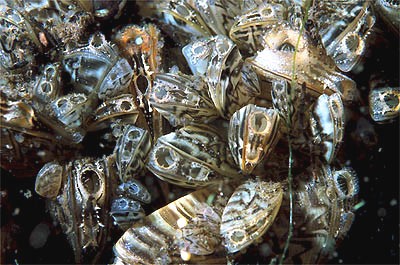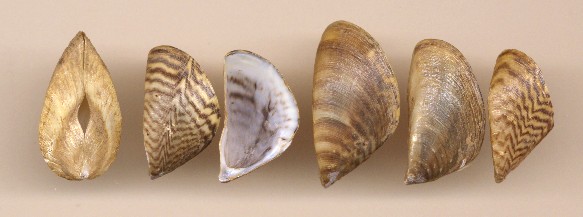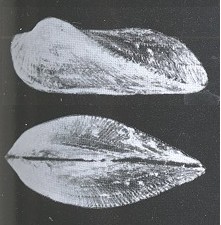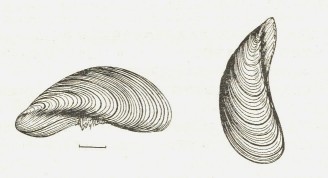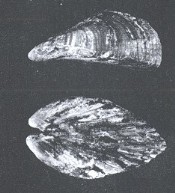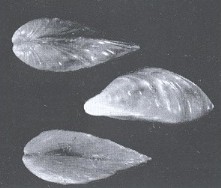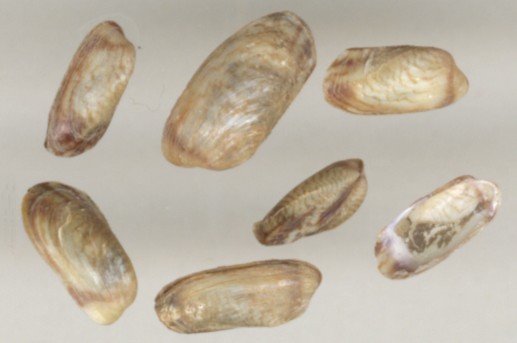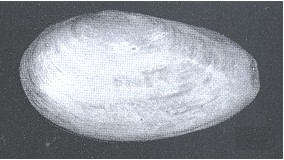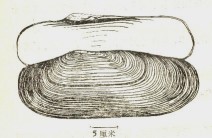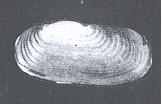Freshwater Molluscan Shells
Dreissenidae: zebra mussels and "false" mussels, including the so-called "platform mussels" of brackish waters.
Dreissena polymorpha. Note well-developed siphons, characteristic
of more advanced bivalves. Such siphons are lacking in marine mussels,
and poorly developed in the Unionaceans. Image courtesy Digischool.nl
through WikipediaThree genera:
Congarea; Florida, Gulf coast and northern South America, west Africa.
Mytilopsis; Europe, West Indies, eastern North America.
Dreissena; Native to rivers draining into the Caspian, Black, and Aral Seas, or the seas themselves; also Tigris and Euphrates Rivers. Invasive elsewhere.Zhadin lists seven Dreissena species for the territory of the USSR:
Polymorpha in the Baltic, Black, Caspian, and Arctic drainage basins;
caspia, in the Caspian and Aral Seas,
pallasi, in the Aral Sea,
andrusovi in the northern Caspian,
distincta in the Caspian,
bugensis in the southern Bug and Dneiper, and
grimmi in the Caspian Sea.Brandt, (1974) includes the two Sinomytilis species from Thailand shown below in this family, due to their having a free-swimming larval stage, but questions that placement. He mentions that the gill structure is more characteristic of the Mytilidae (marine mussels), and it seems they are most likely members of that family.
The zebra mussel is thought to have arrived in the Great Lakes with ballast in the early 1980's. Since then it has been agressively invasive, literally covering parts of the lakebeds in thick masses. The similar "quagga mussel" (D. bugensis) thrives in deeper waters. In 1994, parts of the Illinois River ecosystem were decimated when high temperatures and low oxygen levels caused a die-off, and the effects cascading to other organisms. See http://www.inhs.uiuc.edu/chf/pub/news/hav2.html:
During the summer months of 1993 and 1994, alarmingly low dissolved oxygen (D.O.) concentrations (1.7-3.0 mg/l) occurred in the main channel of the lower Illinois River at sites where we had found the densest populations of zebra mussels in 1993. Extended periods of low D.O. created stressful conditions which may have caused mortality among zebra mussels, native unionid mussels, and several species of fish including gar, catfish, buffalo, and carp, which were floating dead in large numbers during July 1994.
More recently some populations have reached an equilibrium, with carp and crayfish beginning to prey upon them. The conditions favoring invasive exponential reproduction are unclear at this time, and some lakes where they had been seen in low numbers never had a severe infestation.
Dreissena polymorpha (Pallas, 1771). The infamous zebra mussel is native to rivers draining into the
Caspian and Black seas. Individuals show a great variety of shapes and patterns, but all have a
characteristically flattened ventral surface (left) and a gap for the byssal threads.
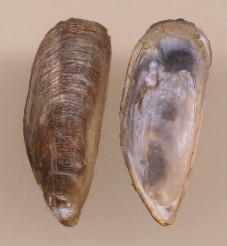
Mytilopsis cochleata (Kickx, 1835) Belgium.
Other freshwater bivalves
Black and white photographic images are from Brandt (1974), line drawings from Liu Yueyin (1979)
Fanily Arcidae arc shells
Scaphula
Scaphula pinna Benson, 1856. Brandt (1974)
writes of Scaphula, that it is the only genus of the
arcidae living in fully fresh water, where they live
attached to solid surfaces by their byssal threads.
He notes two other species in the general region,
S. celox from the Cane River near Banda, and S.
deltae from several localities in India and Burma.
Approx. 12 mm long.
Family Mytilidae, marine mussels, a few of
which have invaded fresh waters.
Limnoperna lacustris (Martens) Bar is 5 mm.
Sinomytilus harmandi
(Rochebrune, 1881)
Thailand.
Sinomytilus morrisoni Brandt, 1974
Thailand. Both species approx. 3 cm.
Family Trapeziidae
Fluviolanatus subtortus (Dunker, 1857) New South Wales, Australia, living in weeds. x8.
Family Solenidae razor clams
Pharella waltoni Brandt, 1974. Thailand,
42 mm long.Family Novaculidae
(= Solecurtidae) razor clams
Novaculina chinensis Liu et Zhang
China.
Novaculina siamensis
Morelet, 1889. Thailand
24 mm long.
